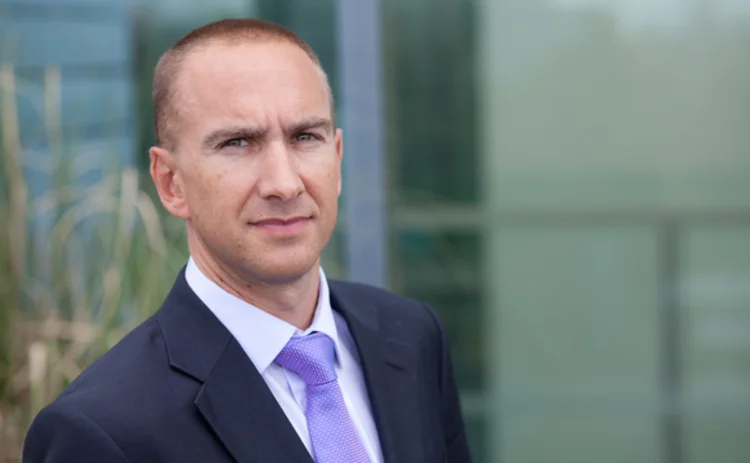The Long Haul: Scott Marcar Leads RBS' Tech Team Through the Financial Crisis

Scott Marcar is leading a team that aims to make RBS’ infrastructure world class. To do it, he’s drawing on lessons learned from the past. By Anthony Malakian
Four years ago, Scott Marcar left his post at JPMorgan Chase to join the Royal Bank of Scotland (RBS). He had been at JPMorgan since 1993, and, as he puts it, saw himself as a JPMorgan “lifer.”
The fact was, though, that JPMorgan had its infrastructure in order. There were no new mountains to climb; rather, the technology needed only a bit of landscaping—at least, that was the case before the Bear Stearns and Washington Mutual acquisitions and subsequent integrations. JPMorgan’s absorption of those two institutions and its relative health made the bank a perceived winner—if there are a winners to be found—of the global financial crisis.
Marcar jumped ship to RBS in 2007, a good year for the bank. The subprime meltdown had yet to take hold in the US and spread to Europe. Marcar was looking for a new challenge, which he found at RBS. Yet, as is often the case, this new opportunity did not immediately play out as he had envisioned.
Meltdown
Marcar, head of risk and finance technology at RBS, joined a team at the bank that was looking to build, from the ground up, a world-class infrastructure. It was like working with a blank canvas, and the team aimed to create something that would put the bank on a par with the JPMorgans of the world.
But then, in October 2008, the global economy suffered an unprecedented crisis. Global institutions that in some cases had stood for more than 100 years were brought to their knees, and a handful famously failed. RBS did not emerge unscathed, and had to be rescued from the brink of collapse by the UK government in late 2008. Instead of focusing on building an elegant new infrastructure for the bank he had only joined the year before, Marcar and his team found themselves holding on for dear life.
Fight for Survival
When the financial world came apart at the seams in 2008, some of the biggest banks in the world faced a previously unthinkable choice: fail, or fight to survive through an unpalatable mix of government bailouts or mergers with former rivals.
Needless to say, in this environment, cash-strapped firms slashed their IT budgets. But RBS turned into the skid and spent more—out of necessity—to keep its head above water. It chose to fight.
“One important thing to keep in mind is that even through the crisis we lost very few people and none of our management team,” Marcar says. “If you think about the pressure we were under, everything that had been written in the press about us, and the fact that people were marching in the street outside our offices—and yet none of the technology senior management team left—that means we must have been doing something right as an organization and a culture. There was very much the attitude that we were in this together,” he says.
The Constant Churn
The challenge that Marcar originally thought he was inheriting was one of underinvestment, which was true. When he arrived at RBS, the firm was installing a new credit derivatives platform for what was to be a complete overhaul of its credit business. The firm’s front office had seen some modest investment, but the middle and back offices were lacking, Marcar says. This deficiency was highlighted during the credit crunch.
“RBS had underinvested in technology for some time,” he says. “They saw technology as a tactical weapon, but if they wanted to have a top markets business, they needed world-class technology. So there was a big push here to turn the organization from a middle-tier player to something bigger. That was really appealing to me, to be at the start of something.”
Fast-forward to the present day. RBS is about 18 months into a five-year plan to transform its infrastructure into a world-class operation. For Marcar, this change comes down to getting the firm’s data right. Part of the impetus for this IT overhaul is the regulatory transformation sweeping across Europe and the US.
“I think the problems we’ve had in the regulatory space—from an architectural perspective—have really been about inconsistency of data,” he says. “There was a disparity of information between risk reports and finance reports—what’s in the balance sheet versus what’s in the capital calculation, as well as risk views versus the balance sheet. Achieving consistency across the organization has been a big challenge. So the real emphasis has been on getting that data architecture right front-to-back, and getting that application architecture right is fundamental.”
‘Spaghetti’ Systems
Much of what Marcar is currently working on pertains to improving RBS’ data architecture. Over the last 18 months, the main goal was to ensure that the firm’s data is clear and correct with no overlaps. RBS had a “spaghetti” architecture with multiple different systems feeding into one another, asynchronously, which creates multiple stores of data across the firm.
As an example, if Marcar and his team want to make a minor tweak, they have to go about making the change throughout 55 systems downstream. So that simple change that should take 20 minutes to implement can take more than a year and a half to deliver.
To answer this problem, Marcar came up with the idea of a data cache—a data store for all transactional data across the firm. All the systems feed into the cache and all of the firm’s operational systems run off that data cache. This massive undertaking began 18 months ago, with the first implementation going live about six months ago.
Over the next couple of years, RBS will continue to populate the cache with additional data so that more users can act on it. This way, the bank avoids having to translate data in-and-out of interfaces and around different data models, which leads to translation errors and misinterpretations, Marcar says.
“Everything we are seeing—and I really do believe passionately in this—comes back to our data architecture. If we get the data architecture story right—that is, we know where we are storing it, we know where the golden sources are, and we know how to represent instruments, trades and transactions—then everything can flow from that. If we get it wrong, it becomes an impossible task. And I think that very few banks have got that right,” he says.
The New Normal
In the aftermath of the crisis, a new regulatory landscape emerged, which changed the way IT projects are implemented, Marcar says. Whereas in the past, IT upgrades were bound by budgets and delivery constraints, they are now tied to strict time frames. Everything is about meeting compliance deadlines or suffering massive penalties.
This shift means that IT teams are on a constant treadmill where achieving a goal isn’t cause for celebration—it means a requirement has been met, and it’s on to the next project. RBS, along with most capital markets firms, has been forced into a position where it has had to make tradeoffs, Marcar says: tactical versus strategic; commercial value versus architectural purity; and doing the right thing versus doing the pragmatic thing. “Frankly, if you don’t hit the regulatory deadlines, you don’t have a bank,” he says.
As a result of these changes, the way firms measure success has evolved. There has been a fundamental shift, Marcar says, away from revenue and profits to liquidity management, balance-sheet management, funding management, and capital management. The reason for that—and this is a lesson from the crisis—is that you can’t achieve profits and revenue during a downturn without proper risk management in place.
The increasingly global and interconnected marketplace will certainly face other crises. How firms manage them will be determined to a large degree by the risk and management technology IT they have in place. What this means, Marcar says, is that sometimes you have to stop front-office, revenue-generating projects in order to take those technologists and move them to back-office projects. He always wants his “A-team” to be brought in for upgrades involving regulations or risk.
“‘Resource liquidity’ in an environment where you are changing direction quickly is of the utmost importance,” he says. Without the right knowledge and IT staff in place, firms are forced to turn to the contractor market, which is time-consuming and expensive, Marcar says.
How to Manage
Marcar points back to a specific instance from his JPMorgan days to illustrate how he tries to manage his team. In the summer of 1993, he began an internship at the bank. He was fresh out of the University of Warwick, where he graduated with a degree in chemistry. Even though his only technology training was tinkering with a computer and creating video games as a kid, he was eventually hired as a full-time programmer on the firm’s swaps trade-capture system.
What struck him the most was that JPMorgan would hire on aptitude and ability—getting the best and the brightest—and not just on résumé alone.
In 1997, he knocked on the door of Vlad Torgovnik, global head of derivatives and exotics IT at the firm. Marcar, who was working off-the-radar at the time in the back office running an accounting assessments team for JPMorgan’s exotics business, had never met Torgovnik before. Marcar was looking for a bit of guidance and a simple introduction. What he found surprised him—and it was a lesson he carried with him to RBS.
“One of the things I remember about that meeting is that he knew exactly who I was; he knew exactly where my career had gone; and he knew exactly what I should be doing for the next five years,” Marcar says. “I thought that this was a guy who is at the crest of the wave. He knew everything about me and I had never met him. That always stuck with me. He was very hooked into the organization. So I tried to take that philosophy with me and get to know all of my team.”
The Way Forward
Marcar joined RBS shortly before the bank’s darkest hours. But unlike Lehman Brothers and Bear Stearns, RBS managed to avoid the abyss.
Still, it will take quite some time to erase the memory of people marching in front of 250 Bishops Gate in London, RBS’ headquarters. To be sure, there is still much to be done.
Marcar left JPMorgan looking for a challenge, which he found at RBS. It hasn’t been easy, but Marcar says he hasn’t looked back. He admits that he’s made mistakes in his career, but says the most important lesson he’s learned is that he must stay the course, even when—as was the case at both JPMorgan and RBS—the firm has done the right thing with “way too small a team.”
In other words, Marcar says, he’s either in for the long haul or he’s out. In for a penny, in for a pound—you either believe in the project or you don’t. Dipping a toe in the water no longer works in this environment, he says.
RBS has a major IT deliverable on the agenda for every month into the foreseeable future. While technology projects rarely go off without a hitch, when you’re battling a regulatory deadline during what may well turn out to be a double-dip recession, false starts aren’t acceptable.
Marcar looked for a mountain to climb, rather than hedges to trim. He got that—though not the way anyone intended—at RBS. It’s daunting, but it’s exciting, too. “Where else would you want to be to tackle the risk and finance infrastructure other than RBS?” he says. “We have the opportunity to take the organization to a completely different level.”
Only users who have a paid subscription or are part of a corporate subscription are able to print or copy content.
To access these options, along with all other subscription benefits, please contact info@waterstechnology.com or view our subscription options here: https://subscriptions.waterstechnology.com/subscribe
You are currently unable to print this content. Please contact info@waterstechnology.com to find out more.
You are currently unable to copy this content. Please contact info@waterstechnology.com to find out more.
Copyright Infopro Digital Limited. All rights reserved.
As outlined in our terms and conditions, https://www.infopro-digital.com/terms-and-conditions/subscriptions/ (point 2.4), printing is limited to a single copy.
If you would like to purchase additional rights please email info@waterstechnology.com
Copyright Infopro Digital Limited. All rights reserved.
You may share this content using our article tools. As outlined in our terms and conditions, https://www.infopro-digital.com/terms-and-conditions/subscriptions/ (clause 2.4), an Authorised User may only make one copy of the materials for their own personal use. You must also comply with the restrictions in clause 2.5.
If you would like to purchase additional rights please email info@waterstechnology.com
More on Emerging Technologies
The next phase of AI in capital markets: from generative to agentic
A look at some of the more interesting projects involving advanced forms of AI from the past year.
Market data costs defy cyclicality
Trading firms continue to grapple with escalating market data costs. Can innovative solutions and strategic approaches bring relief?
As trading firms embrace AI, so do hackers
According to a Google cybersecurity report, cybercriminals are turning to AI to sharpen their attacks.
AI & data enablement: A looming reality or pipe dream?
Waters Wrap: The promise of AI and agents is massive, and real-world success stories are trickling out. But Anthony notes that firms still need to be hyper-focused on getting the data foundation correct before adding layers.
Waters Wavelength Ep. 343: Broadridge’s Jason Birmingham
This week, Jason Birmingham of Broadridge talks with Tony about the importance of fundamentals as technology rapidly evolves.
Data standardization is the ‘trust accelerator’ for broader AI adoption
In this guest column, data product managers at Fitch Solutions explain AI’s impact on credit and investment risk management.
BNY inks AI deal with Google, Broadridge moves proxy voting to AWS, Expero delivers ICE market data, and more
The Waters Cooler: TSX Venture Exchange data hits the blockchain, SmartTrade acquires Kace, and garage doors link to cloud costs in this week’s news roundup.
Everyone wants to tokenize the assets. What about the data?
The IMD Wrap: With exchanges moving market data on-chain, Wei-Shen believes there’s a need to standardize licensing agreements.








